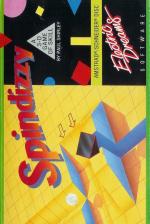
Amstrad Computer User
 1st April 1986
1st April 1986
Categories: Review: Software
Publisher: Electric Dreams
Machine: Amstrad CPC464
Published in Amstrad Computer User #17
Spindizzy
If you can afford to fritter away your change in the arcades you'll be familiar with Marble Madness. It involved rolling a ball across a gridded landscape, negotiating tight bends, narrow ledges and sheer cliffs. Like so many other arcade favourites, it found its way on to a home micro. Now loads of software houses have clones written or planned, the first being Gyroscope from Melbourne "We've never seen Marble Madness, and anyway Gyroscope is totally different" House.
Now we have Spindizzy, a brilliant development of the theme which leaves its rivals for dead and, even so early into 1986, must surely be a contender for Game of the Year. Spindizzy is a huge game, 400 screensfuL which takes the gridded slopes of Marble Madness, complicates them with all manner of ramps, walls, tunnels, lifts and trampolines (honest!), stirs in some fiendish logic puzzles and tops the whole thing off with beautiful graphics and animation which will have owners of other computers drooling. This game is an Amstrad original, and although there will doubtless be conversions, it's hard to see how they can match this.
The object of Spindizzy is to explore the map and collect the flashing jewels which are scattered about it. Some are easily accessible, others perched in devious locations which will need all your skills at problem-solving and joystick control of your spinner, known as Gerald the upside-down triangle.

Often it is not just a matter of selecting the correct route, you need to alter the actual characteristics of parts of the maze by deducing the functions of the icons which litter the floor of the map. These icons are activated by running Gerald over them. but it isn't always that simple - some icons deactivate others, or need to be switched in the right order or at specific times.
Some examples. One icon you'll encounter quite early in the game is a lift, activated by moving on to it. It raises you to a higher walkway leading to an adjacent screen, and lowers you back again when you return.
A much tougher problem is posed by the castle area, which is initially sealed off. How to get the door open? It involves finding which screen elsewhere on the map has the door control, activating this icon, and then finding out how to get back off the screen without deactivating the door. Naturally, the deactivation icon lies on the only exit

Gameplay is against the clock, and there are no lives to lose as such. Normally the clock counts down slowly, but each spinner destroyed decreases the time left by five. Collecting a crystal increases the time and it's a good idea to hit the brake sparingly because it penalises you with a much faster clock rate during use.
It's only too easy to lose spinners - much of the map is set over water, or a drop to infinity, and a misstep results in death. And as the game features true inertia and momentum, if you fall too far on to a solid surface your spinner disintegrates into four pieces with a lovely snapping sound. Conversely a good run-up to a ramp lets you leap wide gulfs.
The game uses Mode 1 to great effect, The restriction to four colours is hardly a limitation, as clever stippling creates a range of hues and shading effects. Moreover, the colour scheme changes in different parts of the map, giving a welcome variety.

The overall map can be called up at any time to check your progress: it shows your current position, which screens you have visited and which of those still have jewels left in them.
The program is full of delightful touches which gives it real class. For example, the spinner's initial appearance is an upturned, spinning pyramid (see the photographs). But if you tire of this, a keypress changes it to either a marble or a gyroscope. Other keys alter your 3D viewpoint to any of the compass points, which is often essential.
Many scenes have tall walls and ramps and the true 3D animation means that crystals, and your spinner, may be hidden from sight in some directions. A compass block indicates true north so you don't lose your bearings on the map.
Finally, any monochrome Arnolds out there can relax, as the programmer has provided a green-screen option which fixes the colour scheme to a set that works best on such monitors. Addictive, surreal, challenging, professional - do yourself and your Amstrad a favour, and get a copy of Spindizzy today.
Other Reviews Of Spindizzy For The Amstrad CPC464
Spindizzy (Electric Dreams)
A review
Spindizzy (Electric Dreams)
A review by Mike Roberts (Computer Gamer)
Spindizzy (Electric Dreams)
A review





